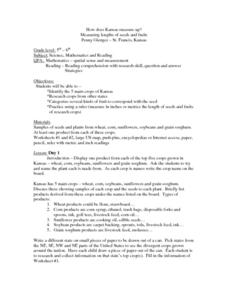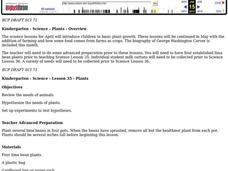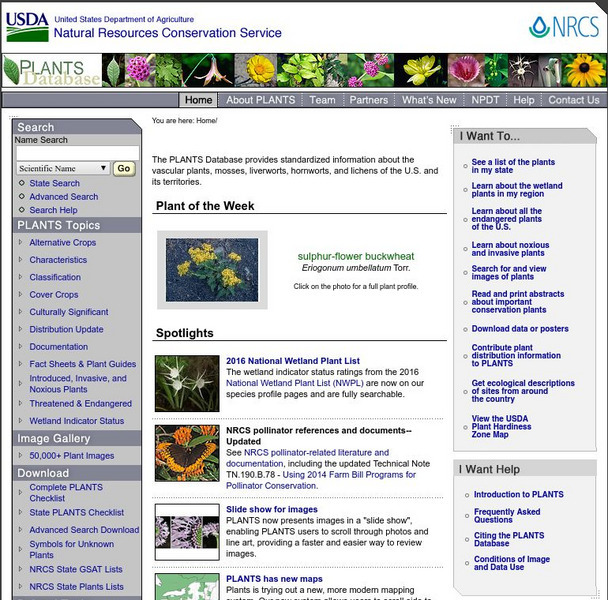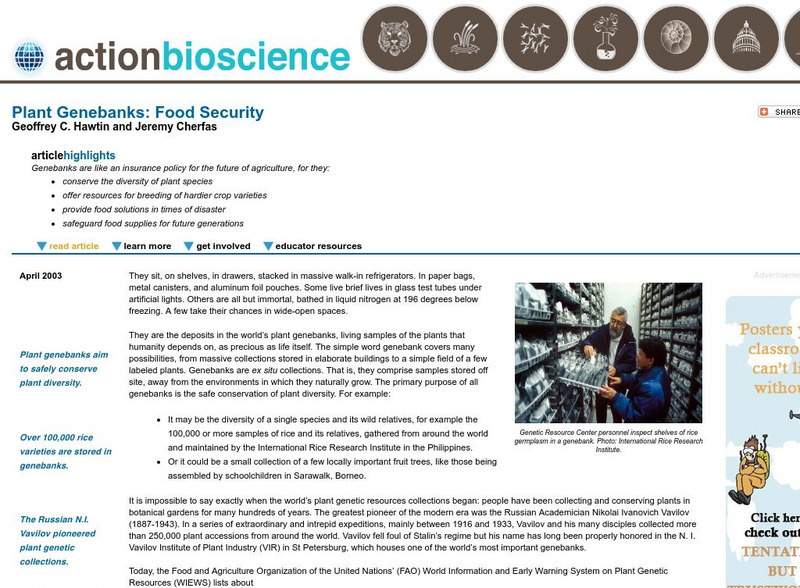Curated OER
Weather Poems
In this weather worksheet, learners use the pictures illustrated to help them unscramble each word to learn a few weather sayings. Then they identify the ways in which meteorologist tracked weather before technology.
Curated OER
Industrialization Word Search
In this social studies worksheet, students identify and locate vocabulary terms related to the Industrial Revolution and industrialization. There are 36 words located in the puzzle.
Curated OER
Snowball Fight
Students examine the weather conditions throughout the globe. As a class, they discover the impact of snow on various types of crops. In groups, they participate in an experiment in which they form raindrops and calculate the...
Curated OER
Crop The Image
High schoolers investigate the skill of using Photoshop software in order to crop an image.They focus on separating one section of a full figure and use a drawing criteria for accomplishing the objectives.
Curated OER
Listening to the Prairie
Students, in groups, visit an exhibit and for a prairie scavenger hunt to locate sunflowers and name products made from them. After sketching a prairie dog, they find nature cues farmers use when growing plants and raising animals. The...
Curated OER
Hunting, Farming and Market Gardening
Students examine the hunting and farming practices of the Black Pioneer. They identify crops raised by black pioneers, and explore the contribution of children to the success of the family farm. Students explore the importance of...
Curated OER
How Does Kansas Measure Up?
Students identify the five main crops of Kansas and crops that are produced in other states. The categorize the types of fruits and seeds of each plant and measure each to compare the length of each.
Curated OER
Kansas Foods A Data and Probability Investigation
Students study a number of food products and anticipate which are derived from Kansas crops. They make a list of words associated with the food stuffs and graph the results.
Curated OER
Plants
Students review the needs of animals, hypothesize the needs of plants, and set up experiments to test hypotheses.
Biotechnology Institute
Biotechnology Institute: Your World: Plant Biotechnology [Pdf]
As humans try to reach the goal of growing enough food to feed all the people, find out how biotechnology is used to help.
Society for Science and the Public
Science News for Students: World's Tallest Corn Towers Nearly 14 Meters
Short nights and a genetic tweak helped novel corn reach record heights in upstate New York. Check out the skyscraping stalks.
US Department of Agriculture
Usda: Plants National Database
This resource provides a database of standardized information on plants. Click on Photo Gallery to view photographs of various categories of plants, including noxious plants and crops.
National Geographic
National Geographic: Staple Food Crops of the World
An interactive map identifying where many of the staple foods are grown around the world. In addition, find questions that can be answered based on review of the maps, fast facts about the crops, and terminology.
Wessels Living History Farm
Wessels Living History Farm
The Wessels Living History Farm of York County, Nebraska, offers a look at what it was like to live on a Great Plains farm in the 1920s. The farm's attractive and well organized website includes interviews with people who remember life...
PBS
Pbs Learning Media: Welcome to City Farm
You're in charge of an urban farm and need to run the farm sustainably for 5 years. Play this interactive game and learn about sustainable practices by growing crops, protecting them against unforeseen problems, and determining how best...
American Institute of Biological Sciences
Action Bioscience: Plant Genebanks: Food Security
Over time everything changes a little bit, just take a look at the theory of evolution. With the descent of biodiversity agriculturalists have developed a system using genebanks to maintain the crops that sustain the majority of the...
TED Talks
Ted: Ted Ed: The Haber Process
Though it has increased food supply worldwide, the Haber process has taken an unforeseen toll on the environment. Daniel D. Dulek delves into the chemistry and consequences of this. [5:19]
TED Talks
Ted: Ted Ed: Do We Really Need Pesticides?
Annually, we shower over 5 billion pounds of pesticides across the Earth to control insects, unwanted weeds, funguses, rodents, and bacteria that may threaten our food supply. But is it worth it, knowing what we do about the associated...
TED Talks
Ted: Ted Ed: What Would Happen if the World Went Vegetarian?
What would the planet look like if everyone became a vegetarian right now? [3:46]
TED Talks
Ted: Ted Ed: How Does It Grow? Apples
Apples are one of the world's most common fruits. They might seem like a simple thing to grow- but they're anything but! [5:33]
Famous Scientists
Famous Scientists: Trofim Lysenko
Meet the Ukranian scientist known for his experimental research in improved crop yields called vernalization. However, he rejected Mendelian genetics in favor of pseudoscientific ideas.
Sophia Learning
Sophia: Hearths of Agriculture
Two period lesson focuses on crop familiarity and its relationship to current agricultural production.
Other
Crop Life Canada
Covers a wide variety of issues from pestcide facts and history to food safety and human health. This organization is involved in all aspects of industry-wide education, communication, legislation, regulation to protecting Canada's...
Northern Arizona University
Land Use History of North America: Prehistoric Farming on the Colorado Plateau
This is an overview of the Anasazi agricultural developments -- despite unfavorable environmental conditions -- which allowed for the formation of settlements and food sharing.











![Biotechnology Institute: Your World: Plant Biotechnology [Pdf] Article Biotechnology Institute: Your World: Plant Biotechnology [Pdf] Article](https://d15y2dacu3jp90.cloudfront.net/images/attachment_defaults/resource/large/FPO-knovation.png)










